
TUESDAY, MARCH 8, 2016

Trouble in Bliss
Living languages evolve
Eric Lee, A-SOCIATED PRESS
TOPICS: CHARLES K. BLISS, SEMANTOGRAPHY, BLISSMBOLICS, LOGICAL LANGUAGE
TUCSON (A-P) — Bliss' life's work was still under way when he died at age 85. He explicitly hoped his work would be carried on by "dear readers." Regarding the system as sacrosanct would be illogical. BCI Bliss is therapy Bliss, a niche of users having no interest in his "Utopian" concerns. The Friends of Bliss (FoBliss) entertain possible tweaks to the language, like all computer programmers either do or are tempted to do. First Linux, then various flavors of Linux. C.K. Bliss copyrighted the system, not to enrich himself, but to retain creative control, to prevent a proliferation of Me-too systems, like the 60 odd spoken constructed languages, that would decrease the likelihood of any one being adopted by the powers that be. Unlike computer languages, a world language needs to gravitate to one form.
C.K. Bliss and his wife spent decades trying to get those in power, whether political, academic, economic, or media movers to get on a Bliss bandwagon and "make it so." The top-down approach didn't work and FoBliss has no intention of carrying on that endeavor. Alternative is a bottom-up approach. Produce a Rosetta book that any bright child could use to teach themselves Bliss—any child, anywhere, regardless of language spoken or level of impoverishment. FoBliss envisions a world were every village has a library, if only a bookshelf on someone's veranda, with several copies of Book00 (Rosetta Bliss) and one copy of Encyclopedia Bliss. Any child so inclined could end up teaching at Oxford.
Avoiding making changes that would render earlier versions unreadable/usable is to be avoided as is a proliferation of dialects, and no major changes appear required. There need be no centralized authority to prevent fragmenting the language into dialects. Those using Bliss will have to put a high value on evolving the language without forming entrenched encampments. If Bliss is not fundamentally flawed it can evolve as one language for one world. If users fragment, the endeavor fails and Babel wins. Failure is an option, but is not inevitable. The evolution of mathematical formalisms is a model. No one owns Math or Bliss as C.K. Bliss concieved it.
An evolving system considers proposed changes in it. "The system" doesn't consider anything, individuals do. Individuals may adopt new conventions for testing purposes. If a convention spreads, changes in Bliss formalism will be made after the fact. Bliss introduced his system as it was evolving in his mind in 1943. His first lecture is a starting point for anyone interested in evolving the system or seeing how ideas evolve.
Spacing
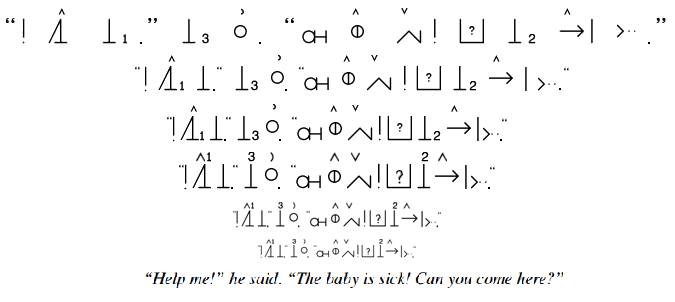 The FoBliss changes proposed are largely stylistic. To make Bliss practical, it cannot take three times more paper to print a book in Bliss than in ASCII text. For thousands of years Chinese writers had to make good use of available paper whose cost was non-trivial. In the future paper may again be a limited resource. Bliss, as the Chinese language did, will evolve to use only as much space as needed. To consider grouping characters closer together must be an option. Spacing will come to be variable and writers and publishers will use what works. Dogmatically insisting that each character (or up to three compound characters and no more) must be separated by a full sized space is fine for children's books, but not for adult reading materials. The only dogmatic determiner needed is a slavish devotion to "What Works." BCI Blilss limits compound characters to three wide, a convention unneeded for adult users.
The FoBliss changes proposed are largely stylistic. To make Bliss practical, it cannot take three times more paper to print a book in Bliss than in ASCII text. For thousands of years Chinese writers had to make good use of available paper whose cost was non-trivial. In the future paper may again be a limited resource. Bliss, as the Chinese language did, will evolve to use only as much space as needed. To consider grouping characters closer together must be an option. Spacing will come to be variable and writers and publishers will use what works. Dogmatically insisting that each character (or up to three compound characters and no more) must be separated by a full sized space is fine for children's books, but not for adult reading materials. The only dogmatic determiner needed is a slavish devotion to "What Works." BCI Blilss limits compound characters to three wide, a convention unneeded for adult users.
Indicators
So, tweaking spacing is one area formalisms will evolve. Actually changing the structure of CK Bliss should be considered with restraint. Bliss, unlike Chinese, uses indicators both above and within lines of symbols. Relatively light use is made of indicators or the space alloted to them. They are smaller than main text. They are readable only if few in number and significantly different in shape. Using ASCII characters l ] [ i 1 I ! } { | would all look the same in small print. Using one vertical line would be readable.
In Bliss an x indicator means "plural." Rotated 90 degrees it becomes a + sign and is different enough in orientation to be readable. This is especially the case if by convention indicators are not printed at 1/4 size (BCI) but at 1/3 size (CK/FoBliss) or even slightly larger to use available space which just happens to be available.
+
2.gif)
A half sized plus sign is used after a character to indicate possessive case. A somewhat obvious convention to save horizontal space would be to move the + up into the indicator area. Indicators qualify symbols and are read first or ignored. If readers tend to ignore them, writers will use bigger sized indicators within the main line area. Some users of BCI Bliss have begun to put the plus sign symbol that is in effect an indicator into the indicator area. If the indicator is placed after a character, no change in meaning, so FoBliss formalism allows pluses to be moved up and if nearly every user (readers being #1) comes to prefer this (or other conventions) the formalism of rules for new users will be updated after the change has occurred.
_
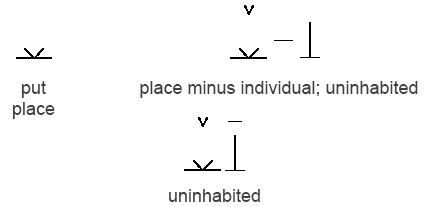 Another equally obvious change would be to move the 1/2 minus sign, often placed before a character to indicate minus, not, un-, an opposite meaning, and move it into the indicator field. As it normally precedes a character, it would precede any other indicators that may be used. It would be the first symbol of any character read or spoken and so the idea of "opposite/negation" would be seen first as it should.
Another equally obvious change would be to move the 1/2 minus sign, often placed before a character to indicate minus, not, un-, an opposite meaning, and move it into the indicator field. As it normally precedes a character, it would precede any other indicators that may be used. It would be the first symbol of any character read or spoken and so the idea of "opposite/negation" would be seen first as it should.
CK Bliss includes a character that means "opposite" and C.K. Bliss intended it to be used instead of the minus sign. In BCI Bliss, use of minus sign is preferred, and why not? The "opposite" character can still be used to limit meaning to opposite. Allowing replacing it with the minus sign works better, is easier to write, so change has happened and in a living language will. Moving the minus sign up may also work.
A mostly stylistic issue is pointer size. In BCI Bliss arrows and pointers are 1/2 size and in CK Bliss and FoBliss they are 1/3 size. Bigger pointers may be best for children's books.
.gif)
123
A slightly more radical change would be to acknowledge that the use of 1/2 sized numbers after characters to indicate first-person, second-person, and third-person, are indicators. If made large enough to still be readable, 123 can be moved to the indicator line. This would not be possible in BCI Bliss. The 1 is represented by a 1/3 vertical line which has no other meaning. The 2 and 3 do not resemble other indicators, though allowing all numbers (for some reason) to be in the indicator position would invite error. They would only be above a few characters that represent humans and other sentient beings who possess things.
With three indicators over a half width character, no space is saved, so location of the 2 to indicate second-person could/should be optional.

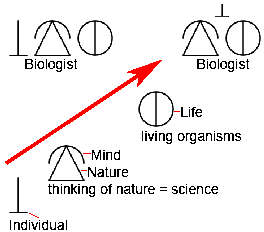 A more heretical change would be to use a vertical bar on a horizontal bar, which resembles a short full-sized character for "individual," to indicate "person." Currently to write "biologist" one puts the "individual" character in front of "biology" to mean "person of biology" or biologist, one who thinks (mind) about biology (life in Nature). There are hundreds of such "words" with the "individual" symbol before them. Every human wants to an "-ist" in something or at least a butcher, baker, or candlestick maker.
A more heretical change would be to use a vertical bar on a horizontal bar, which resembles a short full-sized character for "individual," to indicate "person." Currently to write "biologist" one puts the "individual" character in front of "biology" to mean "person of biology" or biologist, one who thinks (mind) about biology (life in Nature). There are hundreds of such "words" with the "individual" symbol before them. Every human wants to an "-ist" in something or at least a butcher, baker, or candlestick maker.  For all such terms write "meat-cut, bake, candlestick" and put the person indicator above them. Since the proposed indicator is a + sign with the horizontal bar moved down, it looks different and appears readable. It would go first, unless you wanted to write "not a biologist."
For all such terms write "meat-cut, bake, candlestick" and put the person indicator above them. Since the proposed indicator is a + sign with the horizontal bar moved down, it looks different and appears readable. It would go first, unless you wanted to write "not a biologist."
Proper Names
C.K. Bliss attempted to create ideographs for the flags of at least all countries he hoped Bliss might be adopted by. He went for a top-down approach and so tried to placate nationalistic interests. Countries are not so important nor permanent as to merit an ideograph. Some flag ideograms could be constructed and maybe sort of crammed in a little rectangle representing "flag."

In the era of extreme nationistic tribalism, it may not even have occurred to him that ideograms for all contries or other vested interests (states, provinces...) who insist on flag waving are actually needed. All symbols, whether polictical or religious, do not need ideographs. Just use the special symbol as if a picture.  All groups have logograms. Hold up a sign with "USA" on it anywhere and anyone who has watched TV will have seen it. So to write "flag of the USA" in Bliss, use the ideograph for flag and add "USA," or whatever name, current or historical, applies.
All groups have logograms. Hold up a sign with "USA" on it anywhere and anyone who has watched TV will have seen it. So to write "flag of the USA" in Bliss, use the ideograph for flag and add "USA," or whatever name, current or historical, applies.
All proper names cannot be given ideographs. It would be like an historian asking how to write "Julius Caesar" in Bliss. 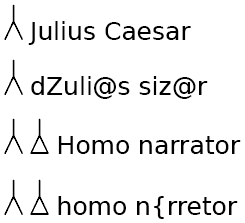 Good question and Caesar, dead and turned to clay, won't mind not having an ideograph bestowed upon him. The way to use proper names is to write in Bliss up to the point a name needs to be evoked and then add the name in Latin letters. If "man" is not enough introduction, add "past man" to note an historical figure.
Good question and Caesar, dead and turned to clay, won't mind not having an ideograph bestowed upon him. The way to use proper names is to write in Bliss up to the point a name needs to be evoked and then add the name in Latin letters. If "man" is not enough introduction, add "past man" to note an historical figure.
Alternative, assuming you wanted to write his name as an American might pronounce it, is to write it in X-SAMPA. An advantage of using X-SAMPA is that you can write how Caesar would have said his name [juliUs kaesar]. In science, millions of species names, not to mention other taxonomic names, are needed. No Bliss names will be constructed. So if you need to use "Hominidae" write it per current international usage.
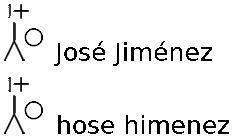
If you need to say "my name José Jiménez" then write "my name" and add your name as you spell it or want it pronounced.
As shown, the names are in /2 size, which is standard when printed large, such as for children or learners to see. If printed in a book, such that the text could still be read, the Bliss characters would be oversized. 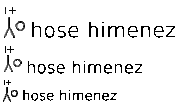 To print the Bliss characters to be readable without wasting paper, the ASCII text would have to be larger, so in FoBliss, the text would be up to 3/4 the height of the mainline with descenders going below it. The intent is to make both the Bliss and ASCII equally readable. No fixed rule, use what works.
To print the Bliss characters to be readable without wasting paper, the ASCII text would have to be larger, so in FoBliss, the text would be up to 3/4 the height of the mainline with descenders going below it. The intent is to make both the Bliss and ASCII equally readable. No fixed rule, use what works.
Ideograph Morphing
 Like Chinese has, Bliss characters will evolve to become more compact to save paper or visual real estate. The extended form would continue to be used, readers would learn the more compact form, and less space used may be a good thing assuming readability is retained. For example CK Bliss for domestic animal shows an implied quadruped that is protected. Alternative would be to combine the two.
Like Chinese has, Bliss characters will evolve to become more compact to save paper or visual real estate. The extended form would continue to be used, readers would learn the more compact form, and less space used may be a good thing assuming readability is retained. For example CK Bliss for domestic animal shows an implied quadruped that is protected. Alternative would be to combine the two.  The protection symbol over animal makes a low triangle that happens to mean "man made" which is appropriate as domesticated animals are bred, are to some extent man made. So apart from using half the space, combining the ideas works and adding the dot makes the character include all animals that have been domesticated. Adding a dog-like tail means canine animal which are quadrupeds
The protection symbol over animal makes a low triangle that happens to mean "man made" which is appropriate as domesticated animals are bred, are to some extent man made. So apart from using half the space, combining the ideas works and adding the dot makes the character include all animals that have been domesticated. Adding a dog-like tail means canine animal which are quadrupeds  so no dot added. Adding claws means feline animal.
so no dot added. Adding claws means feline animal.  Adding protected means "dog"
Adding protected means "dog"  or "cat."
or "cat."  Naming breeds of dog could be by adding a character that, by convention, can be associated with the breed, e.g. Dalmatian.
Naming breeds of dog could be by adding a character that, by convention, can be associated with the breed, e.g. Dalmatian. A wild (non-domesticated) canine that sings would be a coyote,
A wild (non-domesticated) canine that sings would be a coyote,  aka "song dog," and a wild small canine could, per convention, be "fox."
aka "song dog," and a wild small canine could, per convention, be "fox." 
Join the Navy
Here's an example of how Bliss may evolve to become more compact like Chinese did and for the same reasons.
Current Bliss for "navy" is  or many individuals fighting (crossing swords) on water. This is perfectly fine for children.
or many individuals fighting (crossing swords) on water. This is perfectly fine for children.
Superimposing fighting and water remains readable and could be written: 
Adding "many" as an indicator for plural retains the same meaning: 
But using "individual" as a person indicator gets the character from four and a quarter wide to one and a half wide:  for a 350% reduction in space.
for a 350% reduction in space.
A similar reduction gives a compact Blissymbol for "Army"  as many individuals fighting on land. The Air Force fights in the sky:
as many individuals fighting on land. The Air Force fights in the sky: 
Perhaps a more radical possibility would be to add a bar under the X to indicate "more" 
Or above to indicate "most."  which is normally indicated by putting a half sized X and bar before a character.
which is normally indicated by putting a half sized X and bar before a character.
This would add to the number of indicators, which would make better use of the indicator space, this is good provided adult readability is not compromised. This would be tested by printing Bliss as it would be in books to assess readability. Marines would be "more" able land fighters and the Green Berets or other elite force to be the most able:
and the Green Berets or other elite force to be the most able:  Every fighting force has the same hierarchy of ability and the Bliss characters could be claimed by all. To specify, the US Marines would be:
Every fighting force has the same hierarchy of ability and the Bliss characters could be claimed by all. To specify, the US Marines would be:  and US Army:
and US Army: 

